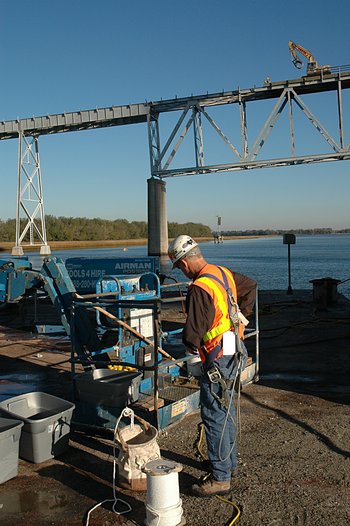Unbuilding the Grace and Pearman Bridges
For Sparky and myself, curiosity drives passion which in turn fuels our life's engine. Our passion was capturing the story of both unbuilding the Grace (1929 - 2007) and Pearman (1966 - 2007) Bridges and discovering the unbuilders. It takes a lot of passion to track a project from July 2005 until April 2007 - rain, shine, hurricanes or moving to Singapore. We discovered the joy of discovery learning. Ken Canty opened the front door for us - then Steve Testa, Ponch Billingsley and Mickey Rogers opened many side doors. Below are the highlights of what we discovered, who we met and what we learned.
And a reminder from T.S. Eliot (East Coker from the Four Quartets)
Home is where one starts from. As we grow older The world becomes stranger, the pattern more complicated Of dead and living. Not the intense moment Isolated, with no before and after, But a lifetime burning in every moment And not the lifetime of one man only But of old stones that cannot be deciphered.

Prep and loading Pier D-25
Implosion References (interesting, instructive and fun reading)
- Learning Links
- Wikipedia: Dynamite
- Wikipedia: Detonation
- Wikipedia: About detonators
- Wikipedia: Shock wave
- Wikipedia: Explosives
- Wikipedia: Blasting caps
- How stuff works: How Building Implosions Work
- How stuff works: Detonators and Dynamite
- How stuff works: Examples
- The History of Explosives and Blasting
- From Dyno Nobel: Shock Tube concepts
- Presentation: The evolution of detonators
- Shock Tube Surface Systems

Our worksite - and note that Pio's quartet: with Richie on the burner, Ted on the concrete cutter and Brad on the grapple are already at work.

We made several video options revealing the dynamics of today's implosion of D-25:
- A short mpg video from my video camera (1.5 Mb).
- A slow motion mpg (courtesy of Jonathan Coultas). Slow Motion (4 Mb quicktime)
- A streaming Slow motion video (wmv) (Courtesy of Jonathan Coultas) that vividly displays the ignition sequence

Lookup up D-25 - drilled and marked

Mickey in different configurations


Some more of Mickey's team: Mickey Rogers, Ken Tully, Dave Holland and Philip Rogers

and here is Bret Rogers - cutting PVC sections

First the tools of the trade - dynamite which creates an compression wave following ignition. This compression wave compromises the structural integrity of the surrounding concrete and rebar. The compression wave is constrained to an axial wave (away from the centerline of the hole that contains the load) by the clay dummy and the stem blocks. Without these each hole would act as a shotgun and the compression wave would propagate down the longitudinal axis of the hole (or barrel in shotgon terminology).

Then clay dummies
 and stem blocks (packages of crushed rock that block the axial compression wave
and stem blocks (packages of crushed rock that block the axial compression wave

Detonators - the silver end is inserted into the dynamite stick and provides a 300 msec delay between activation and ignition

and finally the fuse line - red has a 25 msec delay while yellow introduces a 9 msec delay. These are used to interconnect each loaded hole and provides the time delays for properly sequencing the detonation.

Now for the loading process - first insertion of two sticks of dynamite with an embedded detonator.

Tamping the dynamite cylinder into place

Inserting the clay dummy

Inserting a stemming block. This process is repeated for every hole (approximately 6 foot penetration into the column).

Mickey connecting the detonator to the main system

The left and right array of loaded holes and you can see the different color fuse lines used to sequence the ignition. This is what Mickey and Ken call part science and part instinct. They first develop a plan for the firing sequence and then, when they are loading holes, may make small adjustments in order to achieve the desired explosive action and sequencing.


Making the final connections

and a final inspection. Note that the pier cap overhangs to the left and to the right are connected with yellow lines (9 msec delay). The red lines have 25 msec delay.

and moving our morning home (the barge)

to outside the exclusion zone

and my photo spot, under the Ravenel

At the same time, Pio's team is sawing roadway segments and removing them from the Grace. Here is Richie burning the side guard rails

and a view of the grapple and Pio's team

And the grapple picking up a roadway segment


This work is licensed under a Creative Commons License.
C. Frank Starmer